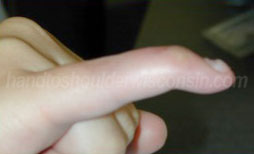The orthopedic doctors and specialists at Hand to Shoulder Center of Wisconsin have been specially trained to treat crushed fingertips and nail bed injuries. When you’re looking for a team of orthopedic doctors and occupational and physical therapists to treat your finger injuries, contact our Appleton or Green Bay location.
What Are Fingertip and Nail Bed Injuries?
Hand injuries are involved in roughly 10% of all emergency room cases with fingertip and nail bed injuries being the most common form. Hand injuries are classified as minor cuts and scrapes, crushing injuries, nail bed lacerations, fingertip amputations, and finger fractures, just to name a few. When a hand injury occurs, it is essential to seek proper care for the injury; if left untreated, loss of function or possibly permanent deformity may occur.
Fingertip and nail bed injuries can result from accidents at home, work, or play. Injuries can include damage to the bones, tendons, nerves, skin, soft tissue, fingernail, and/or nail bed. Crushing injuries typically occur when fingers are caught in a door or machine.
The orthopedic physicians at Hand to Shoulder Center of Wisconsin are highly experienced in all finger injuries and conditions. Common fingertip injuries seen at our Appleton and Green Bay locations include:

Figure 1: Mallet Finger
- Tendon injury – tendons are fibrous bands that attach muscle to the bone allowing flexibility and precise movement of the joint. Tendon injuries typically occur from a cut, tear, or crush injury.
- Ligament injury (sprain) – ligaments are found in the joints and hold the bones together; a ligament injury typically occurs from a blunt blow or obscured stretching movement.
- Dislocation – a dislocation is an injury to the joint alignment; causing it to move out of its normal alignment.
- Laceration – a laceration is a cut penetrating through the skin, depending on the depth of the cut, tendons, and nerves may be involved.
- Nerve injury – a nerve injury typically occurs from a laceration or crush injury; nerves run on each side of the finger giving the finger sensation.
- Fracture – each finger (except the thumb) is formed by three bones (phalanges). Any and all can be fractured (broken) in a hand injury.
- A fingernail or nail bed injury – such injuries are typically caused by a crushed fingertip or laceration.
- Avulsion or nail avulsion – Soft tissue, skin and/or fingernail is torn off in a traumatic accident.
- A compound finger fracture – fractured bone(s) with a laceration.
- A mallet finger – the end of the fingertip droops due to either a fracture of the bone or the extensor tendon is pulled away from the bone; commonly caused from jamming the finger or a forceful blow (Fig. 1).
- Frostbite – skin and underlying tissue is damaged by extreme cold.
Symptoms of Fingertip and Nail Bed Injuries
Depending on the severity of the injury, symptoms can range from slight to extreme pain, tissue loss or amputation, bleeding, swelling, throbbing, or weakness with the inability to straighten and bend the finger effectively.
Diagnosis and Treatment
A thorough evaluation of the injury is performed. All tissue and bone damage along with tendons and nerve sensations are examined. X-rays can be taken to aid in the determination of the presence of a fracture and/or the presence of foreign bodies.
Fingertip surgery varies depending on the extent of the injury. Surgical treatments performed by the fellowship-trained orthopedic surgeons at Hand to Shoulder Center of Wisconsin include but are not limited to:
- Closed fingertip fractures – fractures are reduced (aligned) and a splint may be applied to support and protect the fracture; a temporary metal pin may be inserted to hold the bone in place.
- Lacerations – sutures (stitches) may be applied; if tendon and nerve damage are present a more involved surgery is performed.
- Nail bed injuries – nail bed treatment typically consists of the nail plate being removed, debridement (cleansing) and repair of the nail bed tissue.
- Compound fractures – treatment may include debridement (cleaning) and repair of the fractured bone.
- Fingertip amputations – depending on the degree of the amputation, various methods can be used; full or partial skin grafts, skin flaps, and possibly replantation of the amputated finger.
Depending on the type of fingertip injury and surgery performed, your recovery time will vary. Physical or occupational therapy sessions may be ordered by the surgeon to aid in regaining range-of-motion, instructions in how to reduce hypersensitivity, as well as focusing on finger strength and mobility. Due to the rich level of nerve endings in the fingertip, sensitivity to the fingertip may be affected. Hypersensitivity to cold and residual mild numbness or tingling are common following fingertip injuries.